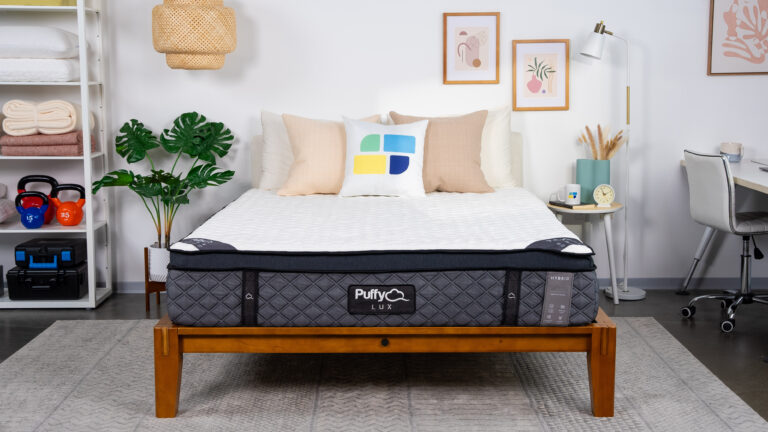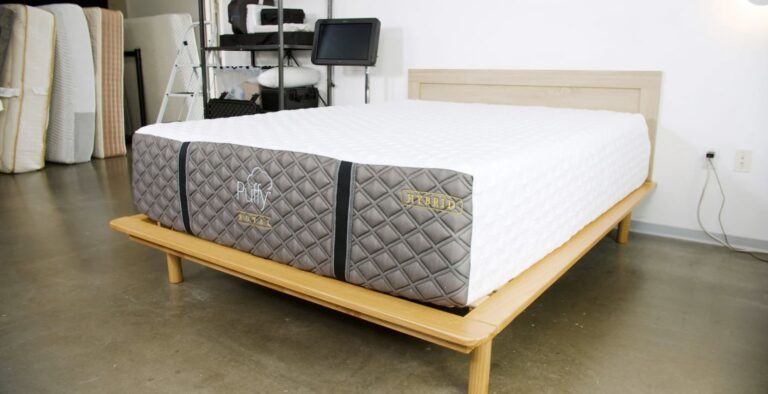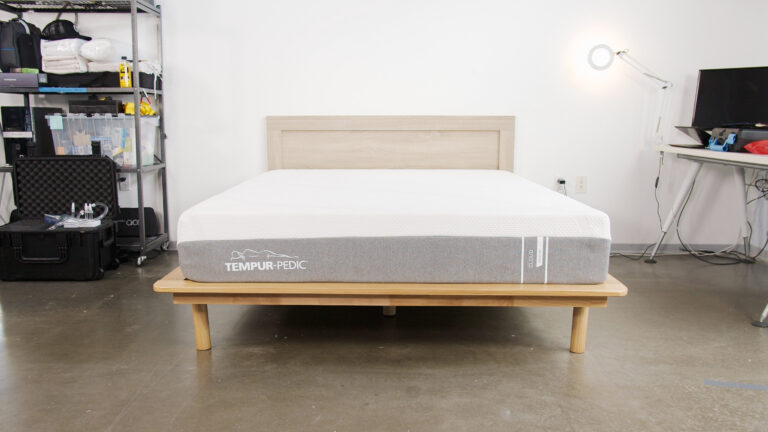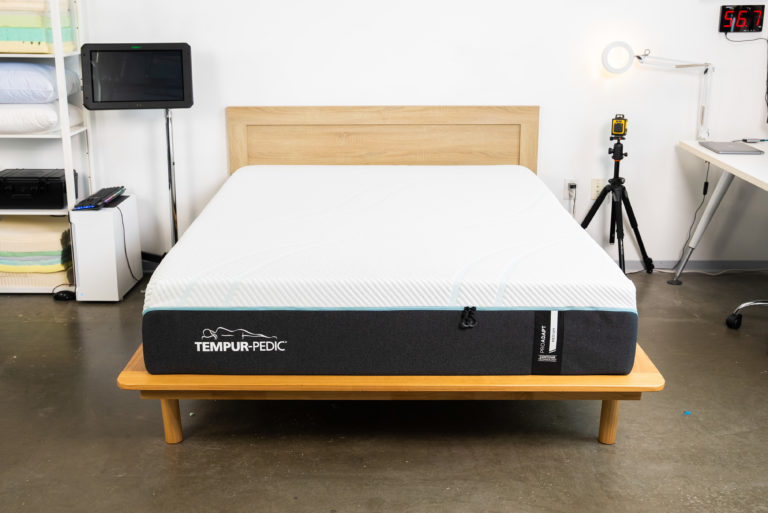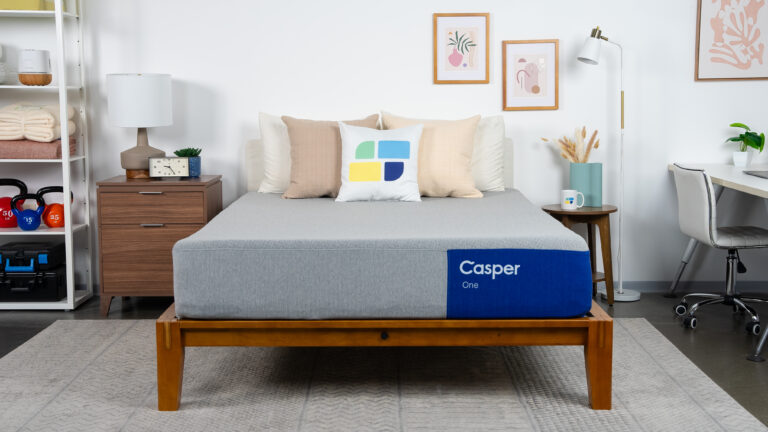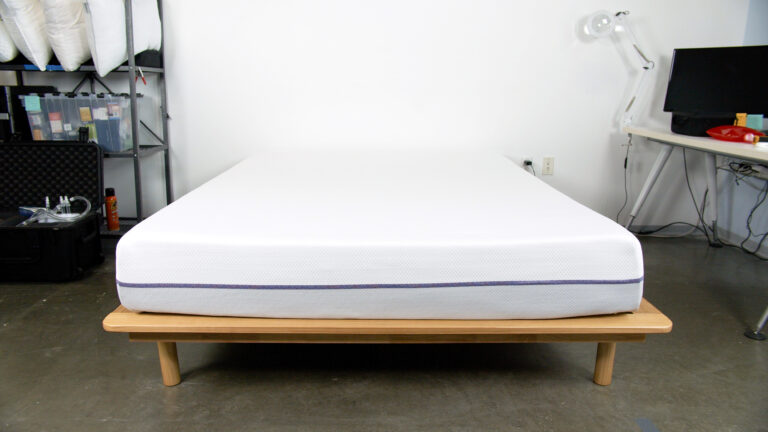When you buy through our links, we may earn a commission. Products or services may be offered by an affiliated entity. Learn more.
Puffy vs. Tempur-Pedic Mattress Comparison
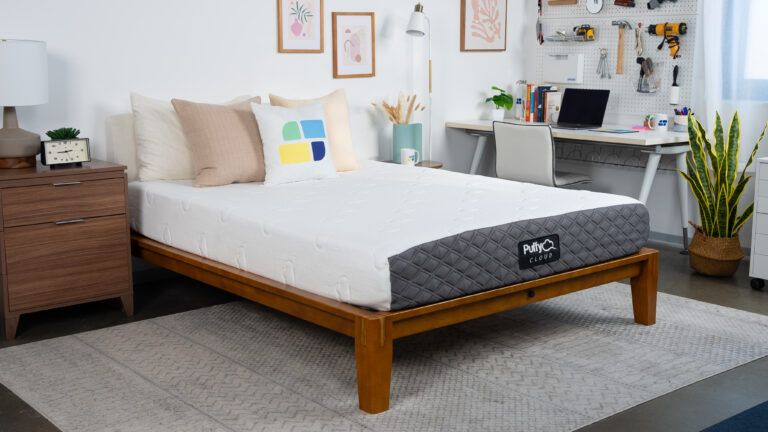
Puffy Cloud Mattress
Bottom Line
The Puffy Cloud uses a combination of memory foam and polyfoam to provide a plush, cushy sleep surface.
$750 off + free accessories at Puffy
Full Mattress ReviewVS
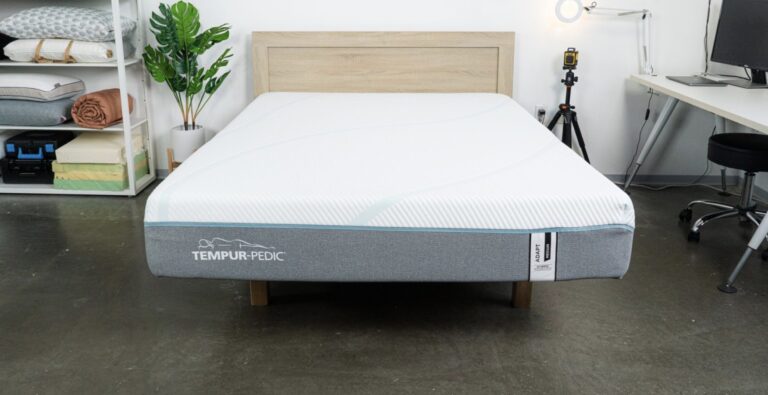
Tempur-Pedic TEMPUR-Adapt
Bottom Line
The Tempur-Adapt mattress uses proprietary memory foams to hug the body deeply and closely for serious pressure relief.
$2,199 from Tempur-Pedic (queen)
Full Mattress ReviewTempur-Pedic needs no introduction: as one of the first companies to incorporate memory foam into mattress construction, this brand revolutionized the mattress industry and has since become a household name. Founded in 2016, Puffy is a newer player that’s carved out a niche in the direct-to-consumer mattress industry with its cloud-like mattresses offered at competitive prices.
At first glance, the Puffy Lux and Tempur-Pedic TEMPUR-Adapt mattresses look very similar. Both feature foam comfort sections with a medium (5) feel and proprietary foams designed for cooling and pressure relief. Both mattresses also come in a hybrid option with a pocketed coil support core. Still, there are a few notable differences that may sway you in favor of one over the other, depending on your sleeping style.
To help you make your choice, we’ll run through the top differences between the Puffy Lux and the Tempur-Pedic TEMPUR-Adapt, incorporating results from our testing as well as mattress specs, pricing, shipping and sleep trial policies.
Quick Look
$1,049
$1,999
Medium (5)
Medium (5)
- All beds constructed with plush and adaptive memory foam
- Excellent motion isolation for couples
- High-density foams offer close conforming and very good longevity
- Ideal for sleepers with frequent back pain and pressure points
- 101 Nights (14-night requirement)
- Lifetime, Limited
- 90 nights (30-night requirement), $175 return fee
- 10 Year, Limited
- A+
- A+
Our Testing Team’s Take
Over the past decade, our testing team has evaluated more than 2,000 mattresses in our Seattle Test Lab. Through this hands-on testing, we’ve developed a unique product research methodology for our mattress rating system.
We use body-mapping technology to identify where pressure points are likely to form. Similarly advanced tools allow us to measure motion transfer across and heat retention across mattress surfaces.
We also have testing team members take mattresses home for weeks at a time, allowing them to mimic real-world use. Because our team members represent a variety of body weights and sleep position preferences, their perspectives can help you identify which might be the best mattress for you.
Our Verdict
The TEMPUR-Adapt and Puffy Lux mattresses contain thick layers of cushioning foams, and either mattress would be a great choice for side sleepers.
The hybrid Puffy and Tempur-Pedic models benefit from the bounce and breathability of their coil support cores, while the TEMPUR-Adapt foam model delivers superior motion isolation for partners who share a bed. The Puffy Lux only comes in a hybrid version, although Puffy does offer a different all-foam model, the Puffy Cloud.

Colin Simpson
Product Research Manager
Side sleeper
190 lbs.
Talks in sleep (like a lot)
“I’m a big fan of the Puffy Lux. Since I’m a side sleeper, I place a lot of value on the ability to cushion my shoulders and hips, and the Puffy Lux has the right amount of cradling to prevent pain in those areas.”
While the Puffy Lux is priced more competitively, Tempur-Pedic has a long track record. Based on this mattress’ materials and build, we feel confident it will offer excellent durability.
Despite their numerous advantages, both of these mattresses create the sensation of lying “in,” rather than “on,” their surface. If you sleep very hot or value being able to change positions easily, you may prefer a mattress with a firmer build.

Jeremy Klein
Senior Product Testing Manager
Side sleeper
160 lbs.
Nightly melatonin user
“TEMPUR foam was a great fit for me as a side sleeper. It had just the right amount of contouring, and its motion isolation absorbed almost all vibration from the other side of the mattress.”
Construction and Materials
The Puffy Lux and TEMPUR-Adapt mattresses both feature multi-layer foam comfort systems. The Puffy Lux and TEMPUR-Adapt Hybrid have a coil support core, while the standard TEMPUR-Adapt has a polyfoam support core.
| Construction Analysis | Puffy Lux | Tempur-Pedic TEMPUR-Adapt |
|---|---|---|
| Cover | Quilted polyester cover with cooling yarns | Stretch polyester |
| Comfort Layer | .5” heat-resistant fiber fill .5” polyfoam (gel-infused) 2” memory foam (gel-infused) | 1.6″ memory foam |
| Transitional Layer | 2” polyfoam | 1.6″ memory foam |
| Support Core | 6” pocketed coils (perimeter foam encasement) 1” polyfoam | Pocketed coils with foam encasement (hybrid model) Polyfoam (foam model) |
Puffy Lux Breakdown
The Puffy Lux is a hybrid mattress with several foam layers over a pocketed coil base. The mattress stands at 12 inches tall and has a medium feel, equivalent to a 5 on our 10-point firmness scale.
Designed with temperature control in mind, the Lux’s cover is woven with cooling yarns and quilted with heat-resistant fiber fill and gel-infused polyfoam.
The comfort system features 2 inches of memory foam with gel infusions designed to draw heat away from the sleeper, followed by a 2-inch layer of denser polyfoam that helps maintain even spinal alignment.
The pocketed coil support core promotes steady airflow, drawing heat out and preventing uncomfortable heat buildup. The coils also add bounce to facilitate movement on top of the bed. That said, each coil is designed to move independently, so you’re less likely to feel disruptions when your partner moves and vice versa.
Tempur-Pedic TEMPUR-Adapt Breakdown
The 11-inch TEMPUR-Adapt features two layers of Tempur-Pedic’s proprietary memory foam, designed to cradle the body and relieve pressure points.
In the hybrid model, the support core is made with pocketed coils that flex independently of each other to provide deep support while boosting airflow and bounce. The foam model has a polyfoam support core, which is better at isolating motion transfer if you sleep with a partner.
Both the foam and hybrid models have a medium (5) feel, although the foam model may feel a tad softer. The cover is designed to be cool to the touch.
Tempur-Pedic also sells spruced-up versions of the Adapt. The ProAdapt and LuxeAdapt models are thicker with more sophisticated features. They’re also available in softer and firmer versions, if you find the medium feel isn’t right for you.
Mattress Sizing and Weight
Both mattresses are offered in the six standard mattress sizes as well as split king. Tempur-Pedic also sells this model in split California king size. The mattress profiles are comparable. Since the TEMPUR-Adapt contains dense memory foam instead of polyfoam, the hybrid model weighs more than the Puffy Lux despite being one inch shorter.
| Mattress Model | Profile | Weight (Queen) |
|---|---|---|
| Puffy Lux | 12″ | 89 lbs. |
| Tempur-Pedic TEMPUR-Adapt | 11″ | 70 or 103 lbs. |
Performance Ratings
With their thick and relatively plush comfort systems, both the Puffy Lux and the TEMPUR-Adapt perform best for side sleepers – particularly those weighing less than 230 pounds. Back sleepers under 230 pounds also receive decent support from the Puffy Lux and the TEMPUR-Adapt Hybrid. All three of these beds are too soft for most stomach sleepers, who typically need a firmer mattress to prevent back pain.
Our testers found the two hybrid models performed similarly for pressure relief and ease of movement. The Puffy earned minimally higher ratings on motion isolation, edge support, and temperature control, while the TEMPUR-Adapt Hybrid produced less off-gassing odor.
Thanks to its foam support core, the TEMPUR-Adapt foam model performed better at motion isolation. However, this model sleeps hotter and can hinder movement when you change sleep positions.
Mattress Pricing
Though the manufacturer’s suggested retail prices are comparable, the Puffy Lux is more likely to have significant discounts that bring it into the average price range for a foam hybrid mattress. Tempur-Pedic is considered a luxury brand and is priced accordingly, with the foam model priced slightly lower than the hybrid model. Tempur-Pedic does have a long track record and the TEMPUR-Adapt rates better for durability, so the investment may pay out in the long run.
Sleep trials and other policies may differ when buying a mattress through third-party channels.
| Policy | Puffy Lux | Leesa Original |
|---|---|---|
| Sleep Trial | 101 nights | 90 nights |
| Warranty | Lifetime, limited | 10-year limited |
| Shipping | Free to all 50 states | Free White Glove delivery to contiguous U.S.; $600 fee for Alaska, Hawaii, and remote locations |
| White Glove Delivery | Not available | Included |
What Customers Are Saying
Puffy and Tempur-Pedic both have thousands of positive ratings for their mattresses. Customers say the Puffy Lux feels soft and hug-like. They also mention that the bed sleeps cool. However, a few shoppers note that the foams start to soften before expected.
Though you may need up to a month to break in the TEMPUR-Adapt, some owners liken the mattress to sleeping on a cloud. Couples appreciate the motion isolation, especially in the foam model. There are quite a few repeat customers replacing a Tempur-Pedic model from several decades ago, indicating that the bed should hold up over time. A few people mention heat retention and ease of movement being an issue.
These warranties are non-transferable, so only you will qualify for warranty coverage – even if you sell or gift the mattress to someone else before the warranty expires.

Still have questions? Ask our community!
Join our Sleep Care Community — a trusted hub of product specialists, sleep health professionals, and people just like you. Whether you’re searching for the perfect mattress or need expert sleep advice, we’ve got you covered. Get personalized guidance from the experts who know sleep best.

